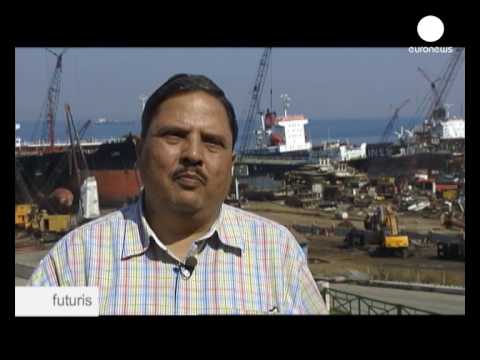Every day, hundreds of workers dismantle large vessels at Aliağa, Turkey, in the heart of ancient Aeolia.
Ships are pulled ashore and cut, piece by piece, over the concrete floor – to prevent any leftover fuel and toxic waste from polluting the ground or spilling into water.
Piles of sorted scrap metal are sent to melting plants that provide up to 3 percent of Turkey’s gross steel production.
Dimitris Ayvatoğlu owns a shipyard in Aliaga. He explains his trade:
“Eventually ships grow older and they need to be disposed of, and the right way to dispose of them is actually to recycle them. There’s a lot of steel onboard the ships – they are made of steel primarily, but there also are other reusable and recyclable materials.”
Worldwide, between 200 and 600 large ships are dismantled every year.
Amid concerns about the human and environmental impact of this industry, the EU is funding a research project aimed to make shipbreaking safer and greener.
It’s called DIVEST (Dismantling of Vessels with Enhanced Safety and Technology) and it looks into every social, technical, economic and environmental aspect of shipbreaking.
Project coordinator Jean-Christophe Saint-Genies spoke of the scheme’s merits:
“What’s unique about our project is the holistic approach to it; the whole integrated approach based on actual studies carried out by the shipbreaking community or even by public bodies. It’s also based on real case studies and analysis done within the industry on different aspects and dimensions of the practice of dismantling,” he said.
Despite international efforts to establish common standards for ship dismantling, current methods and conditions differ significantly from one country to another.
What experts want is a database of reliable information on different practices to help improve the situation.DIVEST’s technical coordinator Selim Alkaner insists on the importance of collecting such information. He said:
“Know your problem first, and observe, and understand, and then start collecting data – measure. If you’re able to measure, you can manage. If you’re not able to measure, you can’t manage. We’re trying to fill that gap by measuring. This is one of the key motivations of that project – collecting quantified data.”
European and Turkish ship dismantling facilities only account for a small fraction of the market.
More than 80% of vessel dismantling takes place in India, Bangladesh and Pakistan, where labour is cheap and ship-owners profit is higher. There is little in the way of impermeable floors or heavy machinery to be seen there: ships are broken on sandy beaches, in sometimes dangerous conditions.
That means high accident rates, health risks and extensive pollution of coastal areas with hazardous materials.
But the industry provides thousands of jobs in poor regions. Besides, manual labour means better sorting: everything valuable is carefully removed from the ship to be reused or recycled, as Shyam R. Asolekar, a Professor at the Indian Institute of Technology Bombay explains:
“It is not ship breaking that we are talking about in India. What we are doing is ship recycling. And that is the immediate distinction of the other ways of ship dismantling and the Indian way of ship recycling – that every component possible is recycled and reused, in some form or the other”.
Price is the decisive factor for ship owners: it pays almost ten times more to scrap a vessel in Bangladesh, where safety standards are the lowest, than it costs to do it in Europe.
At regular DIVEST conferences, scientists present their findings to spread the data throughout the industry.
Meanwhile, in Gothenburg in Sweden rests the carcas of “Full City”. The Chinese oil tanker ran aground in storms off the Norwegian coast, badly damaging its hull and polluting the shore with leaked fuel.
Before it sails back to China, the broken metal plates need to be replaced. This gives researchers an opportunity to measure some of the typical risks of ships dismantling.
Swedish scientists Gunnar Rosén and Ing-Marie Andersson have invented a method to study threat exposure levels – such as puffs of toxic fumes released when cutting metal.
A video camera records all the workers’ actions along with data on smoke levels data, collected with wearable sensors.
In Sweden, workers wear breathing masks to protect them from the fumes. But in South Asian countries, smoke inhalation can kill shipbreakers.
Sonny Nilson understands the risks of the craft. He has been working at the Gothenburg shipyard for thirty years and spoke of the dangers:
“You can get burned. You can fall down from a great height – especially in winter when it’s slippery, and, of course, something can hit your head any moment. I think we’ll be the last generation to work here. It’s a dirty and dangerous job – and kids nowadays prefer to work at their computers.”
Careful analysis of workers’ actions might lead to a reduction of exposure to toxic fumes. And that could save lives. South-Asian governments need this data to push their shipbreaking industry to make real improvements in working conditions.
Of all the main ship-dismantling countries, only India has so far developed some infrastructure for hazardous waste management, workers’ training and health care in the last few years.
Bangladesh and Pakistan are lagging behind – but they too are voicing their intention for improvement.
DIVEST participants state that Chinese ship-breakers, in cooperation with the Chinese government, are actively implementing strong worker training and environmental protection measures in adequate bespoke, benchmark facilities.





